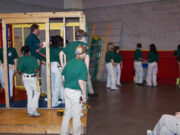Service learning is a method of teaching and learning that helps students to learn academic content and skills by planning and participating in community service activities. Service learning is often confused with volunteering, community service, charity, good deeds, or field experiences. However, the emphasis in service learning is on the learning of content and skills that are consistent with state academic curricula, like Georgia’s Performance Standards (GPS), while addressing real community needs. For this reason, service learning is sometimes called, more descriptively, academic service learning.
The Implementation of Service Learning
Georgia’s educators employ the PARC model to implement service learning programs. The acronym stands for the four stages of service learning: Preparation, Action, Reflection, and Celebration. During the Preparation stage, students, with the help of teachers, parents and caregivers, and community participants, identify a problem that currently exists in their community. Once the problem has been identified, the students analyze the problem and generate a plan that will help redress it. In the Action stage of service learning, students participate in the service activity. The key element of this second stage is that the students, while under appropriate supervision, have ownership of the project. During the Reflection stage, the students are given a structured opportunity to reflect about and critically examine their service activity. Common methods of reflection include journals, projects, and discussions. In the Celebration stage of the PARC model, the students, parents and caregivers, and community participants are acknowledged for their contribution.
A Historical Perspective
Georgia has a significant history of using service learning to encourage students to utilize academic knowledge while accomplishing meaningful community objectives. With this goal in mind, Georgia Learn and Serve was created as part of the federal program Learn and Serve America, which provides grants to schools and community organizations through funding by the Corporation for National Service.
Over the last decade, academic service learning in Georgia has expanded and achieved considerable success. The first director of Georgia Learn and Serve was Evelyn Turner, who served during the 1993-94 academic year. The second director was Jim Conkwright (1994-95), whose objective was to shift from a focus on community service to an emphasis on service learning as a meaningful part of the academic curriculum. To that end, much of the work in Georgia’s service learning that year centered around meeting with curriculum directors, speaking at education forums, and allocating resources toward the schools to emphasize service learning’s value as an effective teaching methodology.
Dick Grover, the third state director (1995-2000), implemented an innovative model for selecting and supporting the recipients of state service learning grants. Regional workshops were held around Georgia to inform individuals about service learning grant opportunities and to mentor them through the grant-proposal process. To further assist teachers and other grant-award winners with the successful implementation of their projects, a technical and evaluation consultant was assigned to each project. In 1996 David Payne of the University of Georgia became the lead evaluator for Georgia Learn and Serve.
In 1996 a state service-learning conference was held at the Emory Conference Center at Emory University in Atlanta and drew more than 300 participants. In 1998 a crucial service learning initiative that trained and established Service-Learning Ambassadors, who would then serve as mentors to new service learning programs, was implemented. In 1999 Georgia Learn and Serve produced a variety of new materials, including a booklet, pamphlet, video, and Web site, and also established a newsletter. During Grover’s administration two Georgia schools were identified as National Service Learning Leader Schools: Carver Magnet High School in Columbus and Dalton High School in Dalton.
The current director of Georgia Learn and Serve is Myra Tolbert. During the 2003-4 school year, she sponsored three conferences focusing on the link between service learning and student achievement. The statewide conference held in Atlanta in September 2003 drew more than 450 attendees, and in 2004 two regional meetings were held: the Northern Regional Meeting in Athens, with 150 educators, students, and community volunteers; and the Southern Regional Meeting in Valdosta, with 450 participants.
Through grants, Tolbert has been able to award thirty-one schools, three regional education agencies, and two universities more than $400,000 for service learning. To support the federal and state requirements related to the No Child Left Behind Act, grants were made to thirteen Title I schools designated as “needs improvement.” These grants are three-year commitments to support training, project design, implementation, and evaluation. This initiative is one of only a few in the nation.




